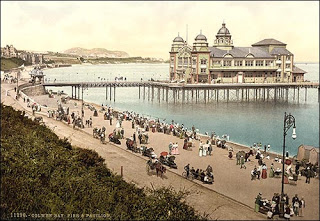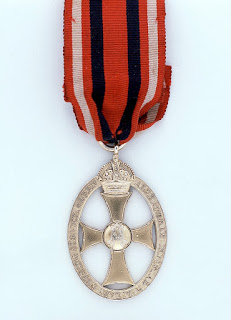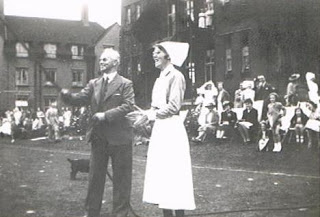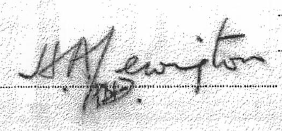German spy, Josef Jakobs, was not a well man when he was found in the early morning hours of 1 February 1941. He had a shattered right ankle which cause him excruciating pain and made movement impossible. After a jostling ride to the Ramsey Police Station in the back of a horse-drawn cart, Josef was seen by local physician Dr. Willem Hertzog who stabilized his lower leg and pronounced him fit for travel to London.
After a brief interrogation at Cannon Row Police Station by Major T.A. Robertson of MI5, Josef received some pain relief from the Divisional Police Surgeon Dr. Marran. He was then sent onwards to the Brixton Prison infirmary where he likely spent an uncomfortable night. His broken ankle needed more care than the infirmary could offer and, on 3 February, Josef was transferred to Dulwich Hospital. After a bumpy few days, Josef was finally able to receive some long-term compassionate care by physicians and nurses who had his best interests at heart. While the name of many of his caregivers have been lost to history, a few can be traced with some confidence.
Dr. Owen William Roberts

Owen W. Roberts was relatively easy to trace. He was the Medical Superintendent of Dulwich Hospital in 1941 and seems to have been the individual who liaised with Major Robertson of MI5 and Dr. Dearden of Camp 020. It was Roberts who repeatedly told Robertson and Dearden that Josef was not well enough to be moved to Camp 020 for further interrogation.
Owen was born 8 March 1894 at Colwyn Bay, North Wales, the eldest son of builder John Thomas Roberts and his wife Elizabeth Jones. Two younger brothers, John Roberts (born ca 1896 in Colwyn Bay) and Hugh Roberts (born ca 1898 in Ruthin) likely kept him on his toes. The family seems to have moved around a fair bit. Owen attended Ruthin Primary School in Ruthin, Denbighshire Wales, but by 1901, the family was living in Twickenham. They then moved to the Croydon area where Owen attended Whitgift Middle School (Croydon) and the Croydon Polytechnic. In 1911, the family was living at Thornton Heath, north of Croydon and both Owen and his brother John were listed as carpenters, clearly following in the footprints of their father. But, for Owen, something shifted. Perhaps the life of a carpenter was not exciting enough, or perhaps he was a bright cookie who was encouraged to pursue something more challenging.
Owen began his medical studies at King’s College, London in 1914 and won the Rabith Scholarship in 1915. That same year he joined the Royal Army Medical Corps and served as a private until 1916 when he returned to his studies after being awarded the Berry Prize and the Warnford Scholarship to King’s College Hospital Medical School. In 1918, he won the Huxley Prize.

On qualification in 1920, Owen was the house surgeon and casualty officer at King’s College Hospital and then assistant medical superintendent at St. Giles’ Hospital, Camberwell, in 1924. By 1930, he was medical superintendent of Dulwich Hospital and also of St. Francis Hospital, Dulwich, in 1932. During that period (1920-1932), Owen earned the following diplomas, degrees, qualifications and memberships: M.B., B.S. 1920 (Bachelor of Medicine, Bachelor of Surgery); M.R.C.S. England (Member of the Royal College of Surgeons of England) and L.R.C.P. London (Licentiate of the Royal College of Physicians) 1920; M.D. 1924 (Medical Doctor); F.R.C.S. England 1925 (Fellowship of the Royal Colleges of Surgeons); and M.S. 1928 (Medical Surgeon).
The following year, Owen married Winifred Eileen Blood, the daughter of Colonel Frederick Blood and his wife, Beatrice Frost. The wedding took place in Wirral, Cheshire, just east of Liverpool, in the summer of 1933, likely in or near Winifred’s home town. Winifred was born in 23 May 1902 in Birkenhead, Cheshire. Winifred studied nursing at St. Thomas’s Hospital in London 1926-1929) and was certified as a Registered Nurse on 27 June 1930. That same year, on 1 August, she became a Staff Nurse in Queen Alexandria’s Imperial Military Nursing Service and it is likely that she and Owen met during the course of their medical careers. I thought that perhaps Winifred might have lost a brother during the First World War, thus triggering an interest in an nursing career but, no, she only had four sisters. And her father, born 1857, served with the 4th Battalion Cheshire Regiment.in France during the the First World War but seems to have survived, passing away in 1942.
Owen didn’t publish much in the medical literature but did pen an important paper in 1928, “Notes on Carcinoma of [the] Prostate” which “included evidence of an intraspinous route of dissemination” thirteen years before Batson describe the role of the vetebral plexus of veins.

In 1939, Owen and Winifred are listed as residing at Dulwich Hospital for the National Registration. There is one closed record after their name, perhaps their youngest daughter. Owen, and the other physicians were listed as A.R.P. Emergency Medical Service (Air Raid Precautions).

During the Second World War, Owen added several other duties to his life. He became medical superintendent of three large refugee centres, the Deaf & Dumb School at Crystal Palace; Anerley House and the Norwood Children’s Hospital and Norwood House.
After the war, in 1949, after the formation of the National Health Service (NHS), Owen was appointed consultant surgeon at Dulwich Hospital.
Owen retired in 1959 and served as a lecturer and examiner for the Surrey branch of the British Red Cross, as well as an examiner for the St. John Ambulance Brigade in the engineering department of the General Post Office. He also served as honorary secretary of the Farnham branch of the Royal National Lifeboat Institution as well as organiser and treasurer of the British Red Cross Society’s old age pensioner’s club in Farnham.
According to his obituary, Owen was a keen gardener, a collector of books and fossils and very much interested in jurisprudence. Owen passed away on 16 July 1976 at the age of 82. He was survived by Winifred, his wife of 42 years, and their three daughters: Beatrice Elizabeth, Janet Ruth and Rachel Eileen.
While Owen was the Medical Superintendent at Dulwich Hospital, and the chief liaison with MI5 and Camp 020, he was not the only physician who took care of Josef Jakobs. I have sifted through Josef’s medical records and pulled out a few other names.
Dr. Harold William Charles Fuller

According to the 1939 National Registration, there was a Dr. Harold W.C. Fuller serving as a Medical Practitioner (i.e. physician) at Dulwich Hospital. This is likely Dr. Harold William Charles Fuller. Harold qualified as a physician on 30 April 1937 at King’s College Hospital, so was quite a young doctor. Despite being young, he had qualified with honours and the university medal, being distinguished in medicine, surgery and pathology. Harold was born 28 August 1914 in Lambeth and commenced his medical studies in 1932. After treating Josef in the spring of 1941, he apparently joined a Red Cross surgical team in Ethiopia and worked in the Haile Selassie I Hospital in Addis Ababa. Later, he worked in Transjordan, Syria and Nazareth before returning to Britain where he entered general practice. While abroad, Harold and his wife Marjorie Dale Noyes gave birth to one child, Peter Michael Fuller, future art critic.
Dr. Leopold Bressloff Bourne

There is no Dr. Bourne listed on the 1939 National Registration at Dulwich Hospital, so it is likely that he joined the staff after that. The 1939 Medical Register lists seven physicians with Bourne as their surname:
- Aleck William Bourne – qualified in1910 as an obstetrician/gynecologist – working at St. Mary’s Hospital in Paddington according to 1939 Nat Reg.
- Arthur Dixon Bourne – qualified in 1931 and serving with the Royal Army Medical Corps
- Geoffrey Bourne – qualified in 1917 and living in Cavendish Square, London
- Gerald Bourne — qualified in 1937 and living in Hampstead, London
- Robert Leo Bourne – qualified in 1930 and, in 1939, living in Cork, Ireland
- Sydney Bourne (formerly Bernstein) – qualified 1927, living in Manchester
- William Arthur Bourne – qualified in 1925 and, in 1939, living in Hove, Sussex
The two most likely candidates are Geoffrey or Gerald, but neither of their write-ups in the 1940 or 1942 Medical Directory mention Dulwich Hospital.
But… a search of the Medical Directory for 1942 revealed this:
BOURNE, Leopold Bressloff, 17, Regency Lodge, Avenue Rd., N.W. 3( Tel. Primrose 4925)–M.R.C.S. Eng[land], L.R.C.P. Lond[on] 1937; (King’s Coll[ege] & Westm[inster]); Ass[istant] Med[ical] Off[icer] Dulwich Hosp[ital] (L.C.C.[???]); Clin[ical] Ass[istant] Centr[al] Lond[on] Throat, Nose & Ear Hosp[ital]; late Ho[spital] Surg[eon] Nat[ional] Temp[orary?] Hosp[ital]; Surg[ical] Clan Line; Cas[ualty] Off[icer] & Ass[istant] Ho[spital] Surg[eon] Westm[inster] Hosp[ital] & Edr[Editor] Westm[inster] Hosp[ital] Gaz[ette] Author, Arts[Articles] on hist[ory] of medicine & travel, Westm[inster] Hosp[ital] Gaz[ette] 1936-40.
By Jove, I think we have our man! While not listed in the 1940 Medical Directory, I did a bit more digging and Leopold underwent a name change in late 1939 according to the London Gazette. He changed his name from Leopold Bresloff to Leopold Bresloff Bourne. Sneaky and understandable given how German such a name sounded.
Leopold Bresslof was born on 24 (or 4th) August 1902 east of the Tower of London to book maker Meyer Bresslof/Bressloff and his wife Jennie Baum. The couple were married in the first quarter of 1900 in London and, while Jennie had been born in London, Meyer was a Russian emigre, possibly via South Africa.
Leopold was the eldest son, preceded by Mabel Bressloff (born 1900) and succeeded by Ethel (born 1909) and Walter (born 1910/1911). The family seems to have lived fairly consistently in the northeast of London, mostly in the Stepney/Stoke-Newington areas. By 1911, Meyer had changed occupations and was now a fishmonger.
Leopold made his London matriculation in June 1919 and in the summer of 1932, started studying medicine at King’s College, London. During the intervening years (1919 to 1932), he seems to have lived at home with his parents and younger siblings. Meyer became a naturalised British citizen in 1925. In 1932, Meyer passed away, still a fishmonger, and this may have given Leopold the impetus to improve his lot in life by studying medicine. A few years later, on Christmas Day 1937, Jennie passed away at Westminster Hospital. Leopold was listed as executor and his occupation was “surgeon”. He had just qualified on 27 October 1937.
The following year, on 10 December 1938, Leopold set sail aboard the Queen Mary from Southampton, bound for New York. Leopold gave his occupation as physician and his religion as “Hebrew”. His nearest relation in England was his brother, W.M. Bressloff of 28 Portsdown Avenue, London. Leopold planned to visit his cousin, M. Bressloff of 744 Joseph Avenue, Rochester, NY. He had dark brown hair and eyes and one of his eyes had a cataract.
Leopold returned to England aboard the M.V. Britannic arriving in Southampton on 24 May 1939 from New York. He was planning to reside at 28 Portsdown Avenue (same address as his brother). Several months later, during the 1939 National Registration, Leopold was staying at 90 Baker Street, Potters Bar north of London. Most of the individuals in the house (12 in all) were Sinclair’s so it’s possible that Leopold was simply a boarder. Interestingly, he gave his surname as Bourne even though the name change only took effect on 28 October 1939 via poll deed. I can only imagine how the name “Leopold Bressloff” would have sounded to the average Englishman. A rather drastic route for Leopold to take, but clearly one that he felt was necessary. Although… his brother, Walter Maurice Bressloff did not change his surname, not even after signing up with the Royal Army Service Corps.
By 1942, Leopold had moved residences and was living at 17 Regency Court, a rather imposing edifice in Swiss Cottage bounded by Avenue Road, Adelaide Road and Finchley Road. After the war, Leopold married Freda D. Balcombe (born 1913) in the fourth quarter of 1945 in Marylebone, Middlesex. They don’t seem to have had any children, at least none that I can find. Leopold passed away in 1975 at the age of 73.
I imagine the irony was not lost on Josef that he, someone who had taken advantage of the Jews in Berlin, was now being treated by a Jewish physician. Of all the physicians who treated Josef, Bourne’s name shows up most often.
Dr. Stephen(s)

Alas, we don’t have quite so much luck with one Dr. Stephen(s). There is no record of a Dr.Stephen(s) at Dulwich Hospital in the 1939 National Registration. Nor do the Medical Directories or Registries yield any likely candidates.
H.A. Lewington

There is an H.A. Lewington who signed off on several of the patient registration forms, making me think that he (or she) worked there in the capacity of a clerical administrator. This same individual was the enumerator for Dulwich Hospital in the 1939 National Registration but, unfortunately, did not include him/herself in that same registration. Who this person was, and what role they played at Dulwich will remain a mystery.
The Radiologist

While most of the signatures are relatively legible… the same cannot be said of the radiologist who reviewed Josef’s x-rays. His (or hers) is the classic indecipherable doctor’s signature.
Conclusion
There were likely many other physicians, as well as nurses, who took care of Josef while he was fighting for his life in Dulwich Hospital. Septicemia and pneumonia were often deadly in the days before penicillin. But, thanks to his excellent medical care, he pulled through. On 27 March, 1941, Josef was discharged from Dulwich Hospital and sent to Camp 020 for further interrogation. His life would be measured in months.
While the names of the nurses who cared for Josef are lost to history, there is one exception, a nurse named Ellen English, whose daughter reached out to me last year. Her story comes next…
Sources
Peerage – Roberts and Blood family
Ancestry – genealogical records including, UK Register of Nurses, UK Medical Directory and UK Medical Registry
Royal College of Surgeons – obituary of Owen William Roberts
British Medical Journal – obituary of Harold William Charles Fuller
London Gazette
